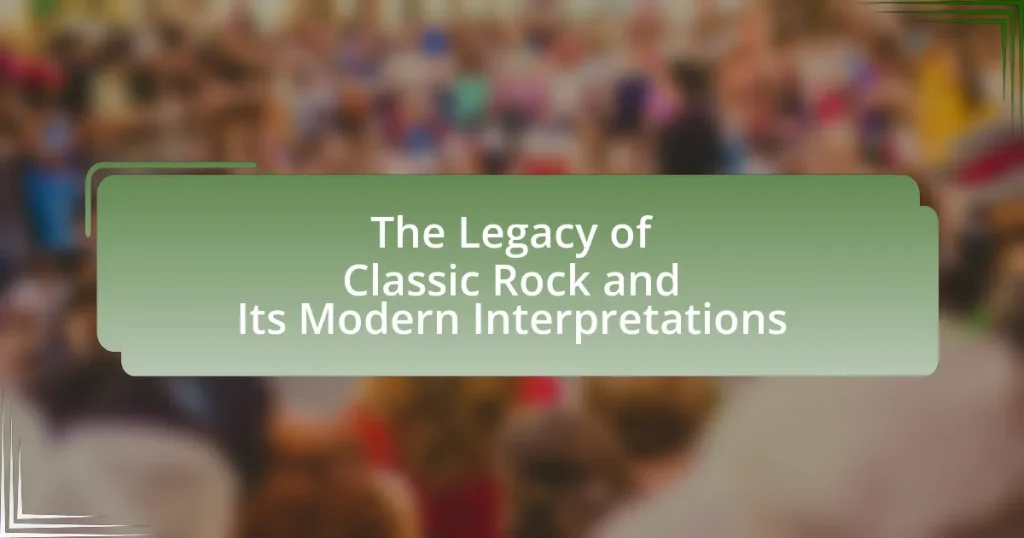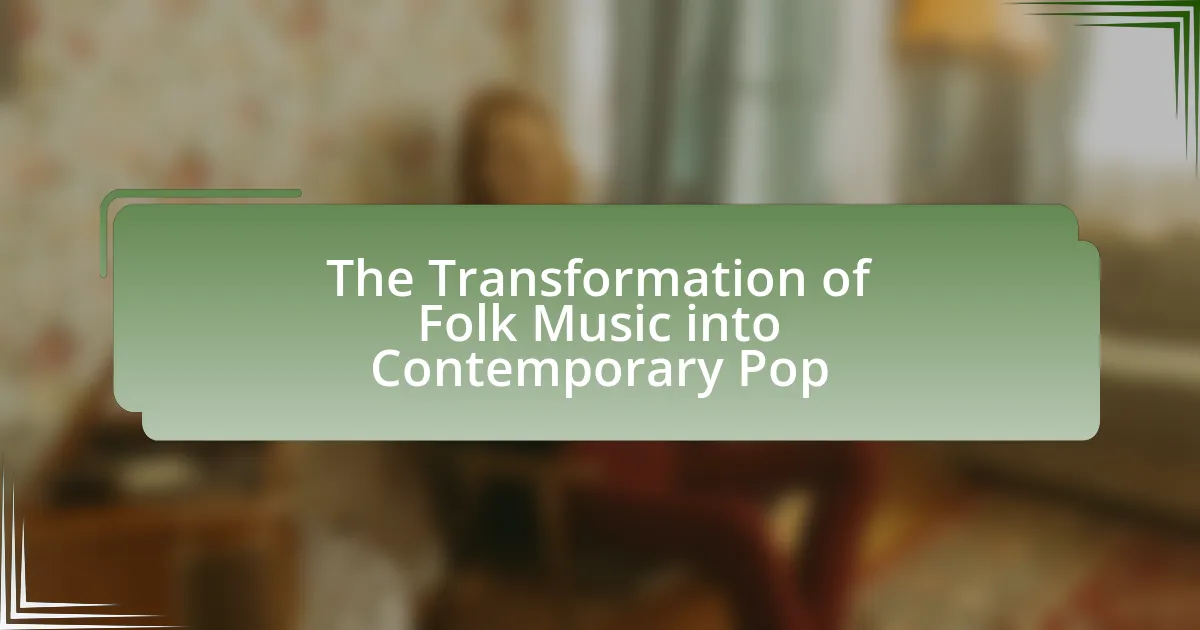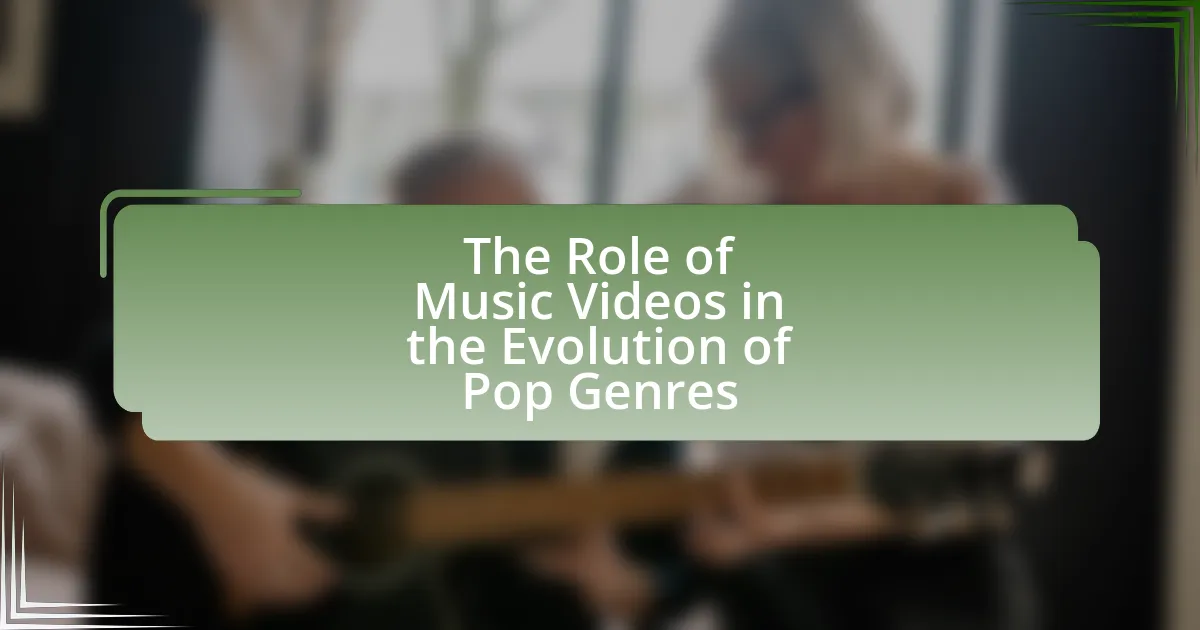The article examines the legacy of Classic Rock, highlighting its significant influence on music, culture, and societal movements from the 1960s to the 1980s. It discusses the emergence of the genre, characterized by iconic bands such as The Beatles, Led Zeppelin, and The Rolling Stones, and their impact on songwriting, instrumentation, and live performances. The article also explores the defining characteristics of Classic Rock, its cultural significance, and how it has shaped modern music and contemporary genres. Additionally, it addresses the challenges and criticisms faced by modern interpretations of Classic Rock, while emphasizing the ongoing relevance of its themes and styles in today’s musical landscape.
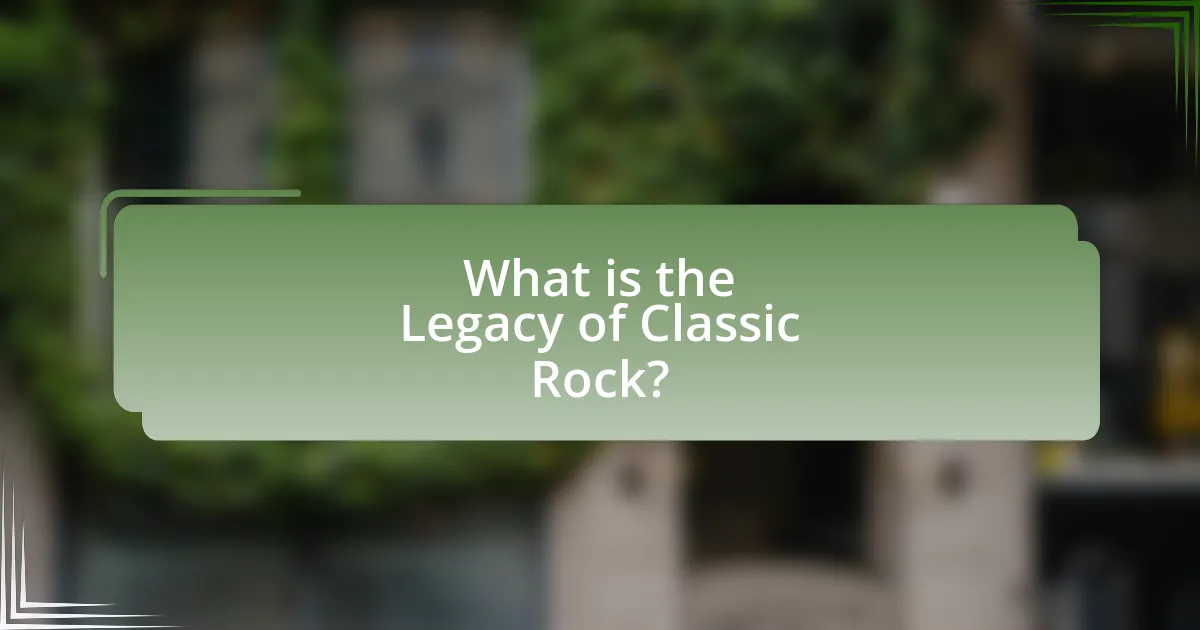
What is the Legacy of Classic Rock?
The legacy of classic rock is characterized by its profound influence on music, culture, and societal movements from the 1960s to the 1980s. Classic rock bands such as The Beatles, Led Zeppelin, and The Rolling Stones not only shaped the sound of rock music but also impacted fashion, attitudes, and the counterculture of their time. Their innovative approaches to songwriting, instrumentation, and live performances set new standards in the music industry, leading to the establishment of rock as a dominant genre. The genre’s themes often addressed social issues, personal freedom, and rebellion, resonating with a generation and leaving a lasting imprint on subsequent musical styles, including punk, grunge, and alternative rock. The enduring popularity of classic rock is evidenced by its continued presence in popular media, radio, and live performances, solidifying its status as a foundational element of modern music culture.
How did Classic Rock emerge as a genre?
Classic Rock emerged as a genre in the late 1960s and early 1970s, characterized by a blend of rock and roll, blues, and folk influences. This genre developed as artists like The Beatles, The Rolling Stones, and Led Zeppelin began to experiment with new sounds, instrumentation, and lyrical themes, moving away from the simpler forms of early rock music. The term “Classic Rock” itself became widely recognized in the 1980s when radio stations began to categorize and play music from this era, solidifying its place in music history. The genre’s popularity was further reinforced by the cultural impact of rock festivals, such as Woodstock in 1969, which showcased the genre’s defining artists and their influence on the music landscape.
What are the defining characteristics of Classic Rock?
Classic Rock is characterized by its emphasis on electric guitar riffs, strong melodies, and a blend of various musical styles, including blues, folk, and country. This genre emerged in the late 1960s and 1970s, featuring iconic bands such as Led Zeppelin, The Rolling Stones, and The Who, which contributed to its distinctive sound. Classic Rock often includes anthemic choruses and extended instrumental solos, showcasing musicianship and creativity. The lyrical themes frequently explore personal experiences, social issues, and rebellion, reflecting the cultural context of the time. The genre’s influence is evident in its lasting popularity and its impact on subsequent music styles, solidifying its place in music history.
Which artists and bands are considered pioneers of Classic Rock?
Pioneers of Classic Rock include artists and bands such as The Beatles, The Rolling Stones, Led Zeppelin, and The Who. The Beatles revolutionized music in the 1960s with their innovative songwriting and studio techniques, while The Rolling Stones brought a raw, blues-infused sound that defined rock’s rebellious spirit. Led Zeppelin is known for their heavy guitar riffs and epic compositions, which set the standard for hard rock. The Who contributed to the genre with their energetic performances and rock operas, influencing countless musicians. These artists collectively shaped the Classic Rock genre, establishing foundational elements that continue to resonate in modern music.
Why is Classic Rock significant in music history?
Classic Rock is significant in music history because it shaped the cultural landscape of the 1960s and 1970s, influencing countless genres and artists. This genre emerged from a blend of rock and roll, blues, and folk music, with iconic bands like The Beatles, Led Zeppelin, and The Rolling Stones leading the way. Classic Rock’s impact is evidenced by its enduring popularity, as songs from this era continue to dominate radio playlists and streaming services, with the Rock and Roll Hall of Fame recognizing many of its artists for their contributions to music. Additionally, Classic Rock laid the groundwork for future genres such as punk, metal, and alternative rock, demonstrating its lasting influence on the evolution of modern music.
What cultural movements were influenced by Classic Rock?
Classic Rock significantly influenced various cultural movements, including the counterculture of the 1960s and 1970s, punk rock, and the rise of alternative music in the 1990s. The counterculture movement embraced Classic Rock as a soundtrack for social change, with bands like The Beatles and The Rolling Stones addressing themes of rebellion and freedom. Punk rock emerged as a reaction to the perceived excesses of Classic Rock, with bands like The Ramones and Sex Pistols adopting a raw, stripped-down sound that challenged mainstream norms. Additionally, the alternative music scene of the 1990s drew inspiration from Classic Rock’s ethos, blending its musical elements with new styles, as seen in bands like Nirvana and Pearl Jam. These movements collectively demonstrate Classic Rock’s enduring impact on music and culture.
How did Classic Rock shape the music industry?
Classic Rock significantly shaped the music industry by establishing a template for rock music that emphasized artistic expression, album-oriented rock, and live performance. This genre, which emerged in the 1960s and 1970s, introduced iconic bands like Led Zeppelin, The Rolling Stones, and The Who, who not only influenced musical styles but also transformed the business model of the music industry. The success of these bands led to the rise of the album as a primary format for music consumption, shifting focus from singles to cohesive artistic statements. Additionally, Classic Rock’s emphasis on elaborate live performances and concert tours set new standards for artist promotion and revenue generation, leading to the modern concert industry we see today. The genre’s enduring popularity has also influenced countless artists across various genres, solidifying its impact on the evolution of music.
What are the lasting impacts of Classic Rock on modern music?
Classic Rock has profoundly influenced modern music by shaping genres, songwriting techniques, and performance styles. The genre introduced elements such as powerful guitar riffs, complex song structures, and a focus on lyrical storytelling, which are now staples in contemporary rock, pop, and even hip-hop. For instance, bands like Led Zeppelin and The Rolling Stones set a precedent for guitar-driven music that persists in today’s rock and alternative scenes. Additionally, the emphasis on live performances and the rock star persona established by Classic Rock artists continues to resonate with modern musicians, influencing their stage presence and audience engagement. The incorporation of Classic Rock’s stylistic elements can be observed in the works of current artists like Greta Van Fleet and Hozier, who draw directly from the sounds and aesthetics of the past.
How has Classic Rock influenced contemporary genres?
Classic Rock has significantly influenced contemporary genres by shaping musical structures, instrumentation, and lyrical themes. For instance, the use of electric guitars, powerful vocals, and anthemic choruses in Classic Rock has been adopted by modern rock, pop, and even hip-hop artists. Bands like Led Zeppelin and The Rolling Stones set a precedent for blending genres, which contemporary artists continue to explore, as seen in the works of artists like Hozier and Post Malone. Furthermore, the storytelling aspect of Classic Rock, often addressing social issues and personal experiences, resonates in today’s music, evident in the lyrics of artists such as Taylor Swift and Billie Eilish. This legacy is reflected in the ongoing popularity of Classic Rock-inspired sounds in current music charts, demonstrating its lasting impact on the evolution of contemporary genres.
What role do Classic Rock songs play in today’s music playlists?
Classic Rock songs serve as foundational elements in today’s music playlists, influencing contemporary genres and appealing to diverse audiences. Their enduring popularity is evidenced by their frequent inclusion in streaming services and radio playlists, where tracks from bands like Led Zeppelin and The Rolling Stones continue to attract millions of listeners. Additionally, Classic Rock’s themes and musical styles have been integrated into modern music, with artists across genres citing these classic tracks as inspirations, thereby ensuring their relevance in the current musical landscape.
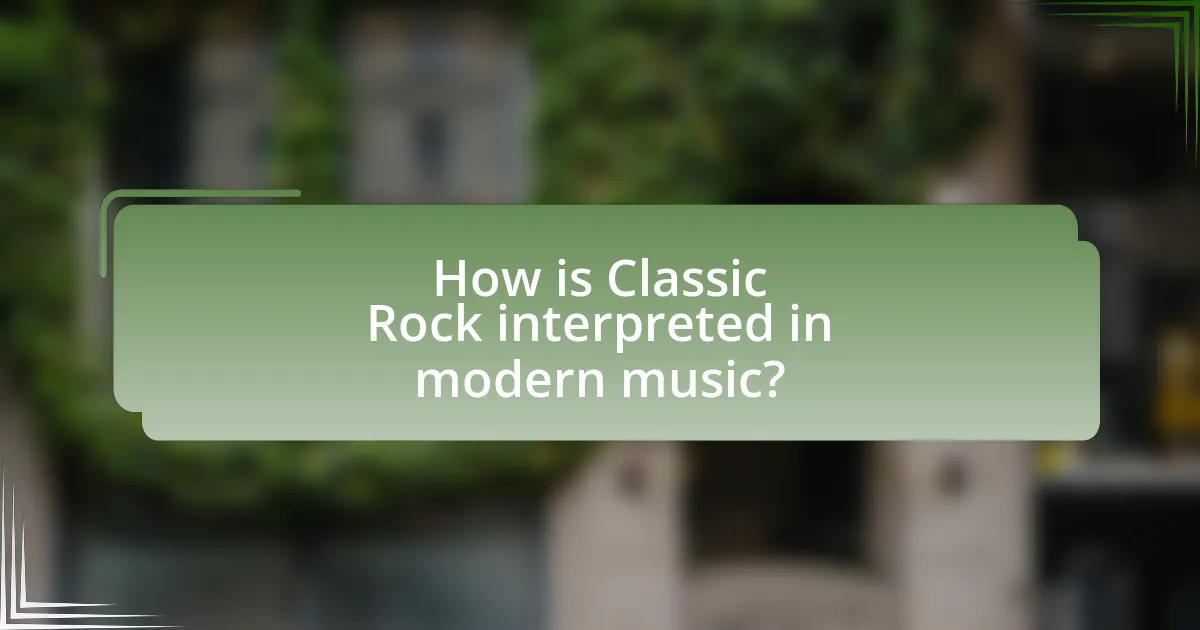
How is Classic Rock interpreted in modern music?
Classic Rock is interpreted in modern music through its influence on contemporary genres, instrumentation, and songwriting techniques. Artists today often incorporate Classic Rock elements, such as guitar riffs and vocal styles, into their music, reflecting the genre’s enduring appeal. For instance, bands like Greta Van Fleet and The Struts emulate the sound and aesthetic of 1970s rock, showcasing how Classic Rock continues to shape modern musical landscapes. Additionally, the resurgence of vinyl records and Classic Rock-themed festivals indicates a cultural appreciation and revival of the genre, further solidifying its impact on current music trends.
What are the current trends in Classic Rock reinterpretations?
Current trends in Classic Rock reinterpretations include the blending of genres, such as incorporating elements of hip-hop and electronic music, as well as the use of modern production techniques. Artists like Greta Van Fleet and The Pretty Reckless are reviving classic rock sounds while infusing contemporary influences, appealing to both nostalgic audiences and new listeners. Additionally, cover albums and tribute projects have gained popularity, with musicians reimagining iconic tracks, showcasing their versatility and creativity. This trend reflects a broader cultural movement where classic rock is not only preserved but also redefined for modern audiences, ensuring its relevance in today’s music landscape.
How do modern artists pay homage to Classic Rock?
Modern artists pay homage to Classic Rock by incorporating its musical elements, themes, and aesthetics into their work. For instance, contemporary musicians often use vintage instruments, such as electric guitars and analog synthesizers, to recreate the signature sounds of Classic Rock bands like Led Zeppelin and The Rolling Stones. Additionally, many modern artists reference Classic Rock in their lyrics, drawing inspiration from the storytelling and emotional depth characteristic of the genre.
Proof of this homage can be seen in the music of artists like Greta Van Fleet, whose sound closely resembles that of classic rock legends, and in the resurgence of vinyl records, which highlights a cultural appreciation for the era. Furthermore, collaborations between modern artists and Classic Rock icons, such as the partnership between Dave Grohl and Paul McCartney, further solidify this connection and respect for the genre’s legacy.
What are some notable covers of Classic Rock songs by contemporary artists?
Notable covers of Classic Rock songs by contemporary artists include Miley Cyrus’s rendition of “Heart of Glass,” originally by Blondie, and Hozier’s cover of “Take Me to Church,” which pays homage to the rock genre’s emotional depth. Additionally, Foo Fighters have covered “Baker Street” by Gerry Rafferty, showcasing their rock roots. These covers demonstrate how modern artists reinterpret classic tracks, often bringing new life and perspective to the original songs.
Why do modern interpretations of Classic Rock resonate with new audiences?
Modern interpretations of Classic Rock resonate with new audiences due to their ability to blend nostalgic elements with contemporary musical styles. This fusion allows younger listeners to connect with the emotional depth and cultural significance of Classic Rock while enjoying modern production techniques and genres such as pop, hip-hop, and electronic music. For instance, artists like Greta Van Fleet and The 1975 incorporate Classic Rock influences into their sound, attracting fans who appreciate both the classic roots and modern innovation. Additionally, the resurgence of vinyl records and retro aesthetics in popular culture has sparked renewed interest in Classic Rock, making it relevant to today’s music scene.
What themes from Classic Rock are still relevant today?
Themes from Classic Rock that remain relevant today include rebellion, love and relationships, social and political commentary, and personal freedom. Rebellion is exemplified in songs like “Born to Run” by Bruce Springsteen, which captures the desire for escape and defiance against societal norms. Love and relationships are explored in tracks such as “Stairway to Heaven” by Led Zeppelin, reflecting timeless emotional experiences. Social and political commentary is evident in songs like “Fortunate Son” by Creedence Clearwater Revival, addressing issues of inequality and war, which resonate with contemporary movements. Lastly, the theme of personal freedom is highlighted in “Free Bird” by Lynyrd Skynyrd, symbolizing the quest for individuality and self-expression, a pursuit that continues to inspire today’s artists and audiences.
How do modern production techniques affect Classic Rock covers?
Modern production techniques enhance Classic Rock covers by incorporating advanced audio technology, resulting in clearer sound quality and innovative arrangements. These techniques, such as digital mixing, auto-tuning, and layered instrumentation, allow artists to reinterpret classic songs with a fresh perspective while maintaining their original essence. For instance, the use of high-definition recording equipment captures nuances that were previously unattainable, leading to a more immersive listening experience. Additionally, modern production enables the blending of genres, allowing Classic Rock covers to appeal to a broader audience, as seen in contemporary renditions that incorporate elements from pop, electronic, and hip-hop. This evolution not only revitalizes the classic tracks but also introduces them to new generations, ensuring their continued relevance in today’s music landscape.
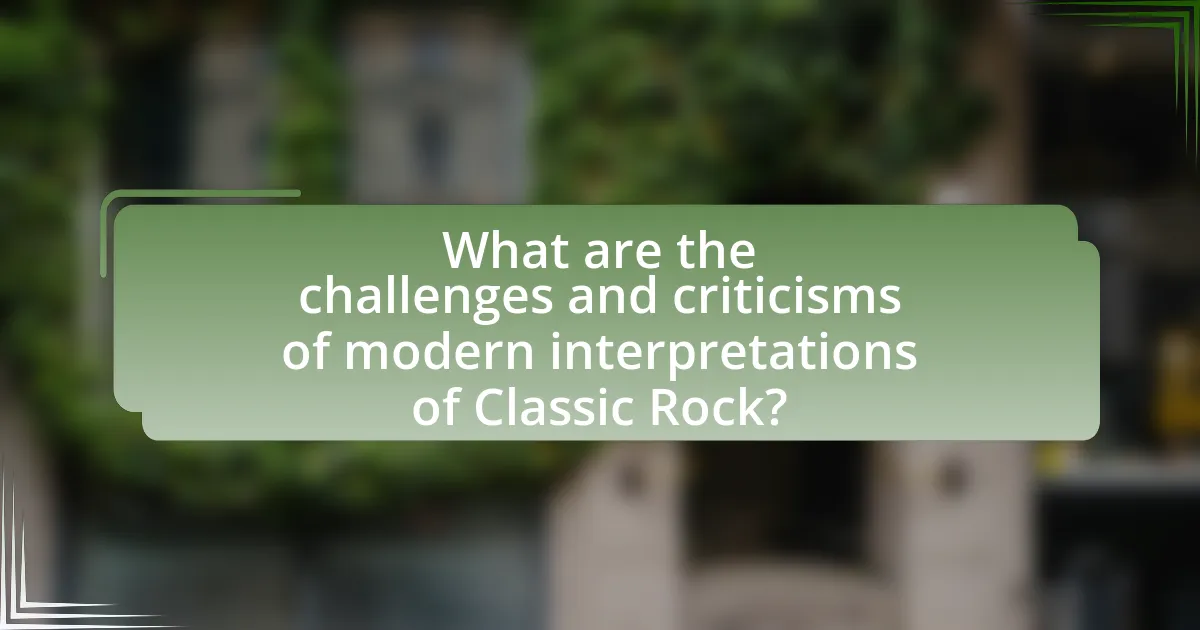
What are the challenges and criticisms of modern interpretations of Classic Rock?
Modern interpretations of Classic Rock face challenges and criticisms primarily related to authenticity, commercialization, and cultural appropriation. Critics argue that contemporary renditions often lack the raw energy and emotional depth that characterized the original genre, leading to a diluted experience for listeners. Additionally, the commercialization of Classic Rock through marketing strategies can overshadow the artistic integrity of the music, transforming it into a product rather than a form of expression. Furthermore, issues of cultural appropriation arise when modern artists borrow elements from Classic Rock without acknowledging its roots, which can lead to a disconnect between the music and its historical context. These challenges highlight the tension between honoring the legacy of Classic Rock and adapting it for modern audiences.
What criticisms do modern interpretations of Classic Rock face?
Modern interpretations of Classic Rock face criticisms primarily for lacking authenticity and originality. Critics argue that contemporary renditions often rely heavily on nostalgia, replicating the sound and style of the original artists without adding new elements or perspectives. This has led to claims that such interpretations dilute the genre’s innovative spirit, as seen in cover bands and tribute acts that prioritize mimicry over creativity. Additionally, some modern artists are criticized for commercializing Classic Rock, prioritizing marketability over artistic integrity, which detracts from the genre’s original rebellious ethos.
How do purists view contemporary renditions of Classic Rock?
Purists generally view contemporary renditions of Classic Rock with skepticism and criticism. They often believe that modern interpretations lack the authenticity and raw energy that characterized the original genre, which emerged in the 1960s and 1970s. Purists argue that contemporary artists frequently prioritize commercial appeal over artistic integrity, leading to a dilution of the genre’s original essence. For instance, purists may cite the use of digital production techniques and auto-tuning as factors that detract from the genuine sound of Classic Rock, which relied heavily on live instrumentation and vocal authenticity. This perspective is reinforced by the belief that the emotional depth and cultural significance of the original works are often lost in modern adaptations.
What are the common pitfalls in modern Classic Rock covers?
Common pitfalls in modern Classic Rock covers include a lack of originality, over-reliance on nostalgia, and failure to capture the emotional depth of the original songs. Many artists tend to replicate the original sound too closely, which can result in a cover that feels uninspired and lacks personal interpretation. Additionally, some covers prioritize commercial appeal over artistic expression, leading to sanitized versions that strip away the raw energy and authenticity that characterized the original tracks. This trend is evident in numerous covers that have been criticized for being formulaic and lacking the innovative spirit that Classic Rock embodies.
How can artists successfully navigate the legacy of Classic Rock?
Artists can successfully navigate the legacy of Classic Rock by blending traditional elements with contemporary styles while maintaining authenticity. This approach allows artists to honor the genre’s roots, such as the use of electric guitars and powerful vocals, while incorporating modern production techniques and diverse influences. For instance, bands like Greta Van Fleet have drawn inspiration from classic rock legends like Led Zeppelin, yet they infuse their sound with a fresh perspective that resonates with today’s audience. This strategy not only pays homage to the past but also attracts new listeners, ensuring the genre’s relevance in the current music landscape.
What best practices should artists follow when interpreting Classic Rock?
Artists interpreting Classic Rock should prioritize authenticity, respect for the original material, and innovation. Authenticity involves staying true to the emotional and musical essence of the genre, which is characterized by its distinct sound and cultural significance. Respecting the original material means acknowledging the contributions of classic artists, such as The Beatles and Led Zeppelin, and understanding the historical context of their work. Innovation allows artists to bring fresh perspectives and contemporary elements to their interpretations, ensuring that the music resonates with modern audiences while honoring its roots. This approach not only preserves the legacy of Classic Rock but also fosters a dynamic evolution of the genre.
How can artists balance innovation with respect for the original works?
Artists can balance innovation with respect for original works by incorporating elements of homage and reinterpretation while maintaining the essence of the original. This approach allows artists to create new expressions that honor the foundational influences of classic rock, such as using similar chord progressions or lyrical themes, while introducing contemporary sounds or personal styles. For instance, artists like Greta Van Fleet have drawn inspiration from Led Zeppelin, blending classic rock elements with modern production techniques, thus respecting the original while innovating within the genre. This method not only preserves the legacy of classic rock but also keeps it relevant for new audiences.
What can listeners learn from the legacy of Classic Rock and its modern interpretations?
Listeners can learn about the evolution of musical styles and cultural influences from the legacy of Classic Rock and its modern interpretations. Classic Rock, characterized by its innovative guitar riffs, powerful vocals, and lyrical depth, laid the groundwork for various genres, including punk, metal, and alternative rock. For instance, bands like Led Zeppelin and The Rolling Stones not only shaped the sound of their era but also influenced contemporary artists such as Foo Fighters and Greta Van Fleet, who draw on similar musical elements. This continuity illustrates how Classic Rock’s themes of rebellion, love, and social commentary remain relevant, allowing modern musicians to reinterpret and innovate upon these foundational ideas.
How can understanding Classic Rock enhance appreciation for modern music?
Understanding Classic Rock enhances appreciation for modern music by providing a historical context and a foundation of musical techniques that influence contemporary artists. Classic Rock introduced innovative songwriting, complex arrangements, and diverse genres, which modern musicians often draw upon. For instance, bands like Led Zeppelin and The Rolling Stones pioneered guitar riffs and vocal styles that are echoed in today’s rock and pop music. Additionally, the cultural impact of Classic Rock, including its themes of rebellion and social commentary, continues to resonate, allowing listeners to recognize and appreciate the evolution of these ideas in modern lyrics and performances.
What resources are available for exploring Classic Rock and its influence today?
Resources available for exploring Classic Rock and its influence today include documentaries, books, music streaming services, and online platforms. Documentaries like “Classic Albums” provide in-depth analysis of iconic albums, while books such as “The Rolling Stone Encyclopedia of Rock & Roll” offer comprehensive histories and insights. Music streaming services like Spotify and Apple Music feature curated playlists that highlight Classic Rock’s impact on contemporary artists. Additionally, online platforms such as YouTube host a variety of content, including interviews, live performances, and fan discussions, which further illustrate Classic Rock’s ongoing influence in modern music.
